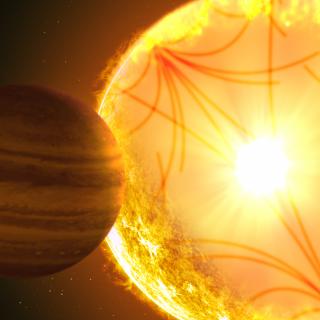Bibcode
Bugnet, L.; Prat, V.; Mathis, S.; Astoul, A.; Augustson, K.; García, R. A.; Mathur, S.; Amard, L.; Neiner, C.
Bibliographical reference
Astronomy and Astrophysics
Advertised on:
6
2021
Journal
Citations
55
Refereed citations
46
Description
Context. The discovery of moderate differential rotation between the core and the envelope of evolved solar-like stars could be the signature of a strong magnetic field trapped inside the radiative interior. The population of intermediate-mass red giants presenting surprisingly low-amplitude mixed modes (i.e. oscillation modes that behave as acoustic modes in their external envelope and as gravity modes in their core) could also arise from the effect of an internal magnetic field. Indeed, stars more massive than about 1.1 solar masses are known to develop a convective core during their main sequence. The field generated by the dynamo triggered by this convection could be the progenitor of a strong fossil magnetic field trapped inside the core of the star for the remainder of its evolution.
Aims: Observations of mixed modes can constitute an excellent probe of the deepest layers of evolved solar-like stars, and magnetic fields in those regions can impact their propagation. The magnetic perturbation on mixed modes may therefore be visible in asteroseismic data. To unravel which constraints can be obtained from observations, we theoretically investigate the effects of a plausible mixed axisymmetric magnetic field with various amplitudes on the mixed-mode frequencies of evolved solar-like stars.
Methods: First-order frequency perturbations due to an axisymmetric magnetic field were computed for dipolar and quadrupolar mixed modes. These computations were carried out for a range of stellar ages, masses, and metallicities.
Conclusions: We show that typical fossil-field strengths of 0.1 − 1 MG, consistent with the presence of a dynamo in the convective core during the main sequence, provoke significant asymmetries on mixed-mode frequency multiplets during the red giant branch. We provide constraints and methods for the detectability of such magnetic signatures. We show that these signatures may be detectable in asteroseismic data for field amplitudes small enough for the amplitude of the modes not to be affected by the conversion of gravity into Alfvén waves inside the magnetised interior. Finally, we infer an upper limit for the strength of the field and the associated lower limit for the timescale of its action in order to redistribute angular momentum in stellar interiors.
Aims: Observations of mixed modes can constitute an excellent probe of the deepest layers of evolved solar-like stars, and magnetic fields in those regions can impact their propagation. The magnetic perturbation on mixed modes may therefore be visible in asteroseismic data. To unravel which constraints can be obtained from observations, we theoretically investigate the effects of a plausible mixed axisymmetric magnetic field with various amplitudes on the mixed-mode frequencies of evolved solar-like stars.
Methods: First-order frequency perturbations due to an axisymmetric magnetic field were computed for dipolar and quadrupolar mixed modes. These computations were carried out for a range of stellar ages, masses, and metallicities.
Conclusions: We show that typical fossil-field strengths of 0.1 − 1 MG, consistent with the presence of a dynamo in the convective core during the main sequence, provoke significant asymmetries on mixed-mode frequency multiplets during the red giant branch. We provide constraints and methods for the detectability of such magnetic signatures. We show that these signatures may be detectable in asteroseismic data for field amplitudes small enough for the amplitude of the modes not to be affected by the conversion of gravity into Alfvén waves inside the magnetised interior. Finally, we infer an upper limit for the strength of the field and the associated lower limit for the timescale of its action in order to redistribute angular momentum in stellar interiors.
Related projects

Helio and Astero-Seismology and Exoplanets Search
The principal objectives of this project are: 1) to study the structure and dynamics of the solar interior, 2) to extend this study to other stars, 3) to search for extrasolar planets using photometric methods (primarily by transits of their host stars) and their characterization (using radial velocity information) and 4) the study of the planetary
Savita
Mathur